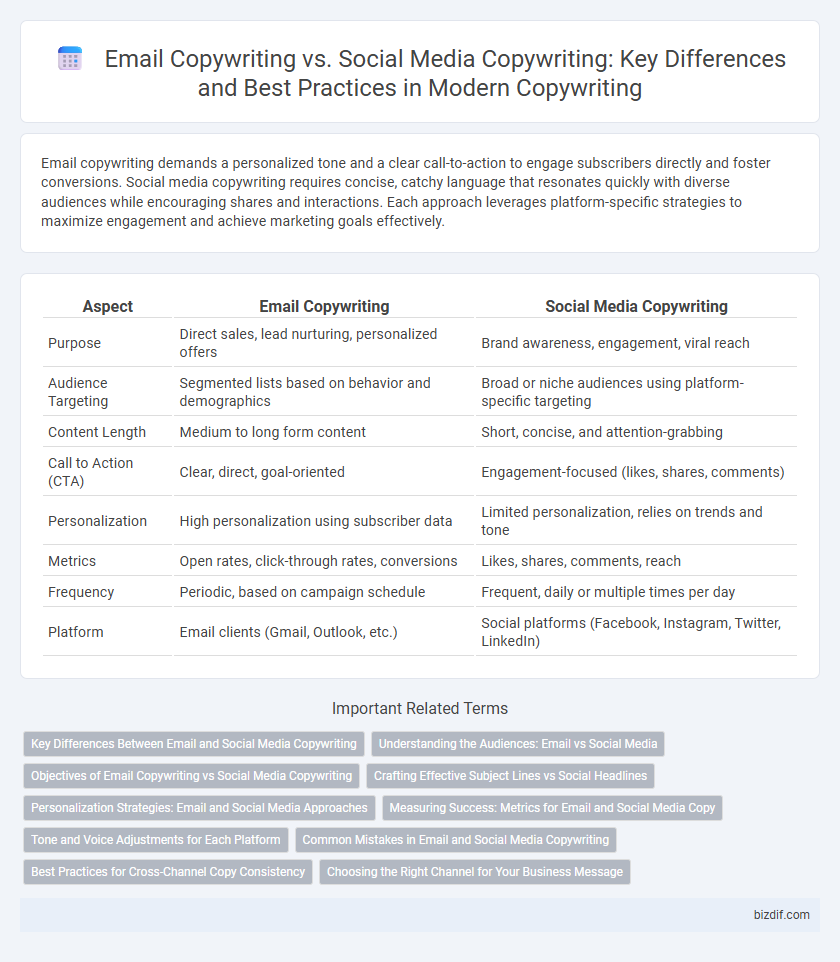Email copywriting demands a personalized tone and a clear call-to-action to engage subscribers directly and foster conversions. Social media copywriting requires concise, catchy language that resonates quickly with diverse audiences while encouraging shares and interactions. Each approach leverages platform-specific strategies to maximize engagement and achieve marketing goals effectively.
Table of Comparison
| Aspect | Email Copywriting | Social Media Copywriting |
|---|---|---|
| Purpose | Direct sales, lead nurturing, personalized offers | Brand awareness, engagement, viral reach |
| Audience Targeting | Segmented lists based on behavior and demographics | Broad or niche audiences using platform-specific targeting |
| Content Length | Medium to long form content | Short, concise, and attention-grabbing |
| Call to Action (CTA) | Clear, direct, goal-oriented | Engagement-focused (likes, shares, comments) |
| Personalization | High personalization using subscriber data | Limited personalization, relies on trends and tone |
| Metrics | Open rates, click-through rates, conversions | Likes, shares, comments, reach |
| Frequency | Periodic, based on campaign schedule | Frequent, daily or multiple times per day |
| Platform | Email clients (Gmail, Outlook, etc.) | Social platforms (Facebook, Instagram, Twitter, LinkedIn) |
Key Differences Between Email and Social Media Copywriting
Email copywriting requires crafting personalized, direct messages with a clear call-to-action to engage subscribers and drive conversions through targeted campaigns. Social media copywriting demands concise, attention-grabbing content tailored to platform-specific audiences, often optimized for shareability and engagement metrics. The primary difference lies in email's one-to-one communication approach versus social media's one-to-many interaction, influencing tone, length, and content strategy.
Understanding the Audiences: Email vs Social Media
Email copywriting targets a segmented, often highly engaged audience, focusing on personalized content that encourages direct responses and conversions. Social media copywriting addresses broader, diverse audiences with concise, visually-driven messages designed for quick engagement and sharing. Understanding these audience dynamics enables tailored strategies that maximize impact across each platform.
Objectives of Email Copywriting vs Social Media Copywriting
Email copywriting focuses on driving direct conversions through personalized messaging and clear calls-to-action, aiming to nurture leads and foster customer loyalty. Social media copywriting emphasizes engagement and brand awareness by crafting shareable, concise content tailored to diverse audience interactions. Both strategies prioritize audience targeting but differ in objectives, with email aiming for measurable responses and social media seeking broader reach and community interaction.
Crafting Effective Subject Lines vs Social Headlines
Effective email subject lines require concise language that encourages high open rates through personalized and actionable phrasing. Social media headlines must capture attention instantly with creative, engaging, and shareable content tailored to platform-specific audiences and algorithms. Mastering subject lines boosts email marketing ROI, while compelling social headlines drive engagement and brand visibility.
Personalization Strategies: Email and Social Media Approaches
Email copywriting leverages advanced personalization techniques such as dynamic content blocks, segmentation by behavior, and personalized subject lines to increase open rates and drive conversions. Social media copywriting emphasizes real-time audience engagement through tailored messaging, interactive content, and targeting based on demographic and interest data extracted from platform analytics. Both approaches rely heavily on data-driven insights to deliver content that resonates with individual users, optimizing response and fostering brand loyalty.
Measuring Success: Metrics for Email and Social Media Copy
Email copywriting success is often measured by open rates, click-through rates (CTR), and conversion rates, indicating how effectively a message engages recipients and drives desired actions. Social media copywriting relies heavily on engagement metrics such as likes, shares, comments, and follower growth, which reflect audience interaction and brand visibility. Both channels require tracking bounce rates and A/B testing results to optimize content performance and maximize ROI.
Tone and Voice Adjustments for Each Platform
Email copywriting demands a personalized, conversational tone that builds trust and fosters a direct connection with recipients, often using a clear and engaging voice to encourage action. Social media copywriting requires a dynamic, concise tone that captures attention quickly and aligns with the platform's culture, maintaining a consistent yet adaptable voice to engage diverse audiences. Tailoring tone and voice for each platform enhances message effectiveness, drives engagement, and supports brand consistency across communication channels.
Common Mistakes in Email and Social Media Copywriting
Common mistakes in email copywriting include neglecting personalized subject lines, resulting in lower open rates, and using overly lengthy content that diminishes reader engagement. In social media copywriting, errors often involve lacking clear calls to action and ignoring platform-specific audience preferences, which reduces interaction and shareability. Both mediums suffer when copywriters fail to optimize for mobile devices, leading to poor user experiences and decreased conversion rates.
Best Practices for Cross-Channel Copy Consistency
Maintaining a consistent brand voice and messaging style across email copywriting and social media copywriting enhances audience trust and recognition. Employ unified tone, language, and key value propositions while tailoring content format to each channel's unique user behavior and platform algorithms. Leveraging data analytics to track engagement metrics enables optimization of copy strategies for seamless cross-channel customer experiences.
Choosing the Right Channel for Your Business Message
Email copywriting delivers personalized, targeted content with higher conversion rates, making it ideal for direct promotions and customer retention. Social media copywriting excels in brand awareness and engagement through concise, shareable posts tailored to platform-specific audiences. Selecting the right channel depends on your business goals, target audience behavior, and the nature of the message you wish to convey.
Email Copywriting vs Social Media Copywriting Infographic

 bizdif.com
bizdif.com